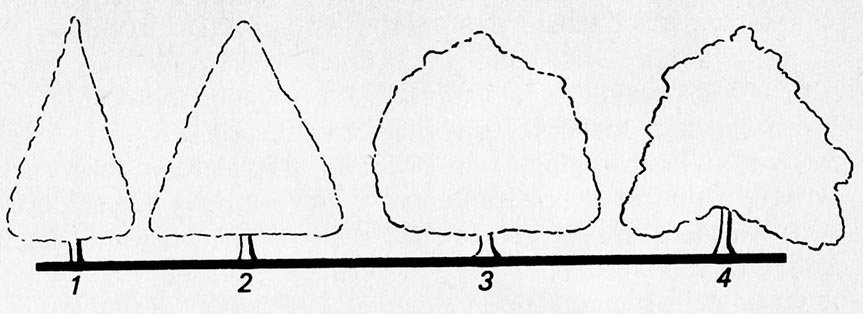 PEAR
PEAR
Pear trees are quite sensitive to low temperatures, and trees of noble varieties can grow to different sizes. Some of them are very large (Good Gray), another – medium size (The favorite), still others – quite small (Josephine). The canopy of trees can be conical (Arrogant), Sphered (Good Gray), copula (The favorite) or irregular (Williams) or it may have an intermediate shape, slightly different from the forms mentioned here.
 Pear crown shapes: 1 – narrow conical, 2 – broad-conical, 3 – Sphered, 4 – copula.
Pear crown shapes: 1 – narrow conical, 2 – broad-conical, 3 – Sphered, 4 – copula.
Pear shoots develop similarly to apple trees. The leaf buds are small, pointed and more or less close to the shoots. The flower buds are larger than the leaf buds and produce flowers and leaves. Pear blossoms are similar to apple blossoms, but mostly white, while the apple trees are pinkish, moreover, their development in the inflorescence is different than in apple trees, where the upper flowers develop first – in the lower pear in the inflorescence. The leaves are usually smaller than the leaves of an apple tree, leathery, shimmering and of various shapes: oval, ovoid and elliptical. The edge of the leaf may be wholly 'serrated” or notched.
Noble varieties pear trees live up to 70 years and longer, but they usually die after 40 years due to easy freezing to harsher winters. Pears grafted on dwarf rootstocks only live 12-20 lat. The greatest productivity of grafted pears on vigorously growing rootstocks occurs in age 20-35 lat. Most pears have quite high soil and climatic requirements. They go on deeper soils, sufficiently airy and fertile. Nobler and winter varieties need more heat than apple trees.
From the selection of varieties recommended for allotment and home gardens, Lipcówka Kolorowa is the earliest. It is an old variety of French origin.. The trees are not growing very vigorously, so that they do not require dwarf washers. The tree forms a lofty crown, conical, little branched, loose, with slightly hanging branches. It enters the fruiting period in 4-5 one year after planting. It bears fruit abundantly, generally alternating, in good conditions and properly cared for, this variety can bear fruit every year. Unfortunately, it is sensitive to frost. It produces medium-sized or small fruit, ovate, size 61X52 mm and weight 75 g. Crumbly crust, slightly shiny, greenish yellow, with a slight reddish-orange, striped blush. Greenish-creamy flesh, not very juicy, not very sweet, quite tasty. The fruit should be harvested a few days before it is fully ripe, most often in the last decade of July. They ripen quite unevenly. Unfortunately, they fall off before harvesting, especially when the tree grows in lighter soil. They override very quickly.
Later maturing, Trewinka is also a summer variety. It is a variety of French origin, relatively little widespread in Poland. The tree grows moderately fast, forming a broad-leaved crown. The fruiting period enters early. It bears fruit very profusely, annually. Resistant to scab, quite sensitive to frost. It produces medium-sized fruit, with dimensions of 65X85 mm and weight 120-140 g, shape reminiscent of the fruit of the popular variety Faworytka, flattened at the calyx and peduncle, tapering upwards. Thin skin, smooth, green-yellow, with a gentle, red, with dots and a striped blush, with often russet stalk. White flesh, juicy, sweet and wine, slightly spicy, quite tasty. The fruit is harvested in the second decade of August. They last for up to two weeks.